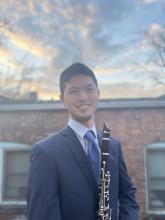The Intersections: SOURCE Poster Session features undergraduates presenting their research and creative projects spanning many disciplines including arts and humanities, life sciences, physical sciences, and social sciences.
All faculty, staff, and students are invited to attend the Intersections: SOURCE Poster Session at the Veale Convocation, Recreation and Athletic Center on Friday, Dec. 9, from noon-2:45 p.m.
Learn more about the work of current undergraduate music majors Anna Pogharian, Andy Regli, and Jeremy Gray.
Improved community engagement of hard-of-hearing individuals at church
Anna Pogharian (Music/Biomedical Engineering), Pierce Boucher, Juan Garcia, William Kozak (Biomedical Engineering)
As part of our biomedical design capstone, my group works with the local congregation of St. Patrick's Church. This church has a high percentage of deaf and hard-of-hearing members who cannot fully engage with the musical elements of the service - particularly the music of the church's historic pipe organ. Our project seeks to create a device that will make the mass's music more accessible for those members of the church community. We are designing and prototyping a device that will transduce music into light to convey the emotional affect of music into a visual medium. This semester, our work has focused on prototyping a proof-of-concept that establishes Arduino code for accurate musical transduction. We will build on this next semester to artistically refine the code and create the physical structure of the device, which will mimic the pipe structure of a traditional organ. I have greatly enjoyed the opportunity to apply my passion for music to my biomedical engineering studies. Anna and Piece are on the biomechanics track and Juan and William are on the biomaterials track.
D.R.U.M.: Digital Rhythmic Utility Modules
Andy Regli (Music/Electrical Engineering), Mark Vaughn (Electrical Engineering), Zach Baldwin (Computer Engineering)
Drum machines are a common tool used by modern musicians to produce drum patterns in songs we hear every day. For artists making their own music without access to the space for a drum kit or the skill to play one, a drum machine can be one of the best alternatives. The problem with current drum machines is that they often sound unrealistic due to three main features. First, most drum machines vary the volume of each sample but do not adjust the intensity of the hit. The second problem is that many drum machines do not have enough variety between samples and can therefore sound ‘over-produced.’ The last problem is timing variety. A real drummer does not hit every beat perfectly so adding options for the hit of a drum to be slightly before or after the beat would make our machine sound more realistic.
Our team has been working towards a preliminary model of a more realistic drum machine. We are focusing on making the base controller and one drum module, the bass drum. The main controller allows the user to sequence a rhythm with the bass drum module and adjust hit intensity per note, while the bass drum module provides the user with a variety of samples and the ability to change the bass drum’s overall volume. Due to the limited scope of this project, we have not focused on the problem of timing variety. However, the machine is designed such that we can address this problem at a future date.
Loss of PLZF drives colon cancer progression through activation of L1 enhancer elements
Jeremy Gray (Music/Biology/Pre-Health)
I studied the dynamic genome of colorectal cancer and looked specifically at the expression levels of a gene known as ZBTB16 which codes for a protein called PLZF. PLZF was shown to be highly expressed in normal colon cell lines but lowly expressed in CRC tumor cells. The question that then arises is why? I further explored the role that PLZF was playing in cancer by knocking out PLZF in CRC tumor cells and overexpressing it in normal colon cells.
Support of Undergraduate Research and Creative Endeavors
SOURCE, the university’s centralized office for undergraduate research, assists and prepares students to engage in research and creative endeavors. It also guides and supplements institutional, departmental, and divisional efforts and programs.




